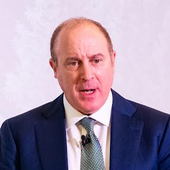
Hedge fund of the year: GoldenTree
Risk Awards 2024: Credit specialist was a big buyer of AT1s during the banking crisis.

One of the most welcome phone calls Steve Tananbaum took this year woke him at two o’clock in the morning.
It was the Monday after Swiss regulators brokered Credit Suisse’s emergency sale to UBS. The caller was Gianfranco Canepa from GoldenTree’s London office. Canepa was calling his boss about a trade that, according to a source close to the firm, would ultimately net the hedge fund more than $100 million.
Bank capital bonds known as AT1s were crashing. And GoldenTree had been purchasing the beaten down securities for several hours already, sure that the panic was unfounded.
Others saw the opportunity, too. But GoldenTree had moved much faster. Canepa was contacting Tananbaum, the $53 billion investment manager’s founder and CIO, to discuss a specific purchase. But the firm had laid out its wider plans the day before.
“There are times when you’re woken up and you’re surprised. And there are times when you’re thinking, what took you so long,” Tananbaum recalls. By 7.30am London time most of the buying and selling was done.
The AT1s trade says much about how GoldenTree works. In the days and sometimes hours during 2023 when opportunities arose to profit in uncertain markets, the hedge fund moved quickly.
There are times when you’re woken up and you’re surprised. And there are times when you’re thinking, what took you so long
Steve Tananbaum, GoldenTree
As well as trading around the Credit Suisse collapse, GoldenTree bought beaten-down CLOs during the UK’s gilt crisis.
And when nervous lenders – afraid of an impending recession – were turning deals away, the hedge fund was happy to step in and take their place. The firm points to a $300 million loan to a major women’s apparel retailer in the second half of 2022 as a headline win.
GoldenTree’s approach demands patience. “They can be very opportunistic,” says a client. “At the same time, they have no problem with pulling back and not doing anything if the opportunity isn’t there.”
Equally, it depends on being prepared for when circumstances are favourable. GoldenTree was able to take a quick view on AT1s because of its breadth of experience in credit markets, including as a player in other bank restructurings.
When UK insurers began dumping CLOs to raise cash last September, the firm’s loan-level repository of data in its CLO business meant it could price any deal within an hour.
Its approach to risk management helped, too. GoldenTree takes a top-down macro-driven view of when to increase or trim exposures. That meant it retained a “significant amount of buying power” in late 2022 when credit spreads looked tight versus history, says Lee Kruter, head of performing credit.
During the US banking crisis, GoldenTree put that cash-on-hand to work. Then, as high yield spreads returned to tighter levels during the third quarter this year, the firm once more reduced positions.
First mover
On the Sunday before Canepa called Tananbaum, Swiss regulators had surprised investors by writing down Credit Suisse’s AT1s to zero even while protecting common stock holders, who received Sfr3 billion in the UBS acquisition.
On March 20, then, investors were panicking and selling other AT1s that might prove vulnerable to similar treatment in future. GoldenTree was confident the Swiss regulator’s action would be a one-off.
The plan hatched in phone calls on Sunday afternoon comprised a wish list of target names, price levels and sizes for buying AT1 bonds, details of which GoldenTree had shared with its brokers. Broadly, the firm was looking for total returns of 25% or more.
By the time New York came in, all the buying opportunities were gone
Lee Kruter, GoldenTree
On the Monday, Canepa arrived at the London office at 4am and sat waiting for the phone to ring. By around 5.30am GoldenTree was buying bonds that were down 25% in clips of $50 million or more.
The best of the opportunity was fleeting. Within two hours, GoldenTree was well on its way to having purchased $400 million face value of AT1s, and the rest of the market had woken up and was trying to do the same.
“By the time New York came in, all the buying opportunities were gone,” Kruter remembers. By its own reckoning, GoldenTree accounted for a fifth of all trading in AT1s on the day and two-fifths of the trading in the bonds it targeted.
At around 10am the European Central Bank, European Banking Authority and Single Resolution Board released a joint statement affirming that AT1s ranked senior to common equity. At around 2pm, the Bank of England followed suit. As confidence returned, AT1 prices started to retrace.
Panic sellers
The past 18 months have offered other opportunities to shop for bargains too.
Tananbaum likes to say that fear brings out more sellers than buyers. And in mid-2022, fear of a recession in the US was front of mind for investors. Strains on companies that had financed at low rates were becoming clear. Investors were drawing back or seeking credits with higher yields to compensate for the greater risk.
GoldenTree took a different view. “That was a poor play to run,” Tananbaum says. Blindly chasing higher yields means missing out on good trades, while increasing the risk of investing in poor companies.

Tananbaum saw instead a chance to negotiate “materially better” terms on solid credits – without being too greedy. “If you can have half the debt and 75% or 80% of the yield, that’s a good marker,” Tananbaum says.
He points again to GoldenTree’s $300 million loan to the women’s retailer. The yield on that deal was 12%. But Tananbaum says it was the creditor protection that made the transaction so attractive. GoldenTree secured a 75% excess cashflow sweep provision, an original issue discount price of $97 and $104 call protection.
At times the firm moved deliberately, at others it was more reactive. In September 2022, for example, GoldenTree stepped in as UK insurers dumped CLO assets to raise cash to meet unforeseen margin calls.
At that time, the hedge fund bought half a billion dollars of cheap CLO debt. “That’s something we knew to do instantly,” Tananbaum says, snapping his fingers.
Taking chances
The numbers bear out GoldenTree’s ability to take its chances. The firm’s flagship fund has returned close to 10% year-to-date and 10% annualised since inception in 2000. Returns over the past three years have been above 14%.
Most of the AT1 bonds GoldenTree purchased were up 15 cents on the dollar before the end of Monday, March 20. Within two weeks some of the larger investments were up 25 cents on the dollar. GoldenTree made about a 40% total return on the trade.
By the end of the year, the women’s apparel retailer had lifted its profit forecast by a fifth. And by early in 2023 a hundred million dollars had been paid down through the cashflow sweep. The full loan was called a few months later, when the company’s private equity owners merged the business. GoldenTree’s return was around 20%.
Equally notable, though, are GoldenTree’s numbers from 2022, which were a modest 1.62% net but came at a time when risk assets such as high-yield bonds lost more than 11%.
Local knowledge
The firm’s breadth helps it identify and capitalise when chances are on offer.
GoldenTree has always been committed to investing across multiple markets. “If you have a broader lens, you have a broader playbook,” Tananbaum says.
Tananbaum himself exhibited wide investing tastes before founding the firm. At one time he was among the biggest holders of certain Latin American corporate debt, at another, one of the top holders of certain Asian convertibles.
In its distressed investing team GoldenTree has 16 restructuring specialists, with 17 years' average experience. That team provided helpful insight during the Credit Suisse write-down, says Kathy Sutherland, GoldenTree’s chief executive.
The conviction that regulators would act to restore confidence in AT1s came from having owned debt in Austrian retail bank BAWAG and in the UK’s Co-operative Bank. Those experiences left GoldenTree with a keen sense of how far European banks depend on a functioning AT1 market.
Patience
But the firm does not charge hard into every gathering storm.
Its drive to take risk when others seek safety comes with a willingness to step back when good deals are harder to find. “When there are fewer opportunities, we want to be able to raise a lot of cash and get ready for when there are better ones,” Tananbaum says.
When there are fewer opportunities, we want to be able to raise a lot of cash and get ready for when there are better ones
Steve Tananbaum, GoldenTree
In late March, unlike others, GoldenTree chose not to trade Credit Suisse CDSs, for example. “We thought it was indeterminate what was going to happen. We didn’t play that,” Tananbaum says.
GoldenTree, meanwhile, diligently reviews its idiosyncratic bets to determine whether to keep them in the book.
And it addresses broader risks from the top down. A group of the firm’s partners chaired by Tananbaum gathers regularly in its macro risk committee to form a view on market and economic conditions, and to consider portfolio-level hedges.
In 2022, a long position in the Goldman Sachs financial conditions index protected against tightening financial conditions. Going short crude oil – a straightforward bet on a weakening global economy – has helped this year.
Pockets of opportunity
GoldenTree expects to grow its investment team of 95 by a tenth this year. The executive team, meanwhile, seems keenly focused on the kinds of deep, structural changes that are likely to create opportunities in future.
GoldenTree’s private credit strategy, for which the firm is now raising capital, seeks to benefit as banks pull back from lending, for example.
Already, the firm has made more than 20 loans in a business that has built up a lower risk profile than allocators might expect. Nine tenths of the loans are first lien. Borrowers’ average Ebitda is $520 million. The average yield to maturity is 13%.
Meanwhile, executives are formulating expansion plans in real estate too. “There’s an air pocket now where a lot of the typical lenders in the space are pulling back or leaving,” Kruter says.
GoldenTree has a long history in real estate debt, adds Sutherland. “We continue to think about the right team structure to have in place, and then the right product offering.”
Here, others might see mostly risk. But Tananbaum dismisses negative headlines around hybrid working and its effect on commercial real estate.
“Office space makes up only around 5% of the US real estate debt market. That leaves a large part of the market that is not going through major structural change,” he says.
“We believe there will be a lot of transactions with attractive risk-adjusted returns and that this is a great time to be growing our presence.”
Only users who have a paid subscription or are part of a corporate subscription are able to print or copy content.
To access these options, along with all other subscription benefits, please contact info@risk.net or view our subscription options here: http://subscriptions.risk.net/subscribe
You are currently unable to print this content. Please contact info@risk.net to find out more.
You are currently unable to copy this content. Please contact info@risk.net to find out more.
Copyright Infopro Digital Limited. All rights reserved.
As outlined in our terms and conditions, https://www.infopro-digital.com/terms-and-conditions/subscriptions/ (point 2.4), printing is limited to a single copy.
If you would like to purchase additional rights please email info@risk.net
Copyright Infopro Digital Limited. All rights reserved.
You may share this content using our article tools. As outlined in our terms and conditions, https://www.infopro-digital.com/terms-and-conditions/subscriptions/ (clause 2.4), an Authorised User may only make one copy of the materials for their own personal use. You must also comply with the restrictions in clause 2.5.
If you would like to purchase additional rights please email info@risk.net
More on Awards
Trading systems: structured products/cross-asset – Murex
Murex won the Trading systems: structured products/cross-asset award at the 2025 Risk Markets Technology Awards for its MX.3 platform, praised for its flexibility and advanced analytics
Best vendor for system support and implementation: Murex
Murex has won the Best vendor for system support and implementation at the Risk Markets Technology Awards, recognised for its innovative MX.3 platform, exceptional client support and seamless implementation services
FRTB-IMA product of the year: Murex
Murex wins FRTB-IMA product of the year for its advanced, scalable MX.3 platform enabling seamless regulatory compliance
Pricing and analytics: equities – Finastra
Finastra’s Sophis platform wins the Risk Markets Technology Award for Pricing and analytics in equities, recognised for its robust capabilities in equities and derivatives trading
Best execution product of the year: Tradefeedr
Tradefeedr won Best execution product of the year for its API platform, which standardises and streamlines FX trading data, enabling better performance analysis and collaboration across financial institutions
Collateral management and optimisation product of the year: LSEG Post Trade
LSEG Post Trade wins Collateral management and optimisation product of the year for interconnected services that help mitigate counterparty risk and optimise capital usage
Clearing house of the year: LCH
Risk Awards 2025: LCH outshines rivals in its commitment to innovation and co-operation with clearing members
Driving innovation in risk management and technology
ActiveViam secured three major wins at the Risk Markets Technology Awards 2025 through its commitment to innovation in risk management and technology








